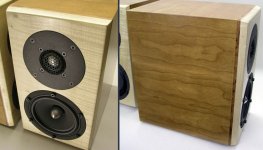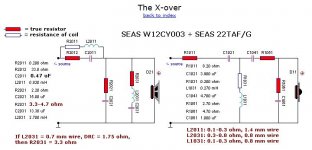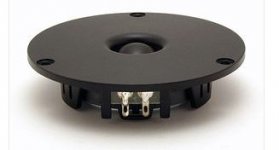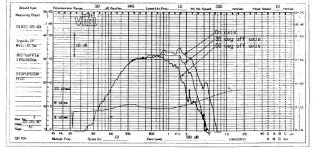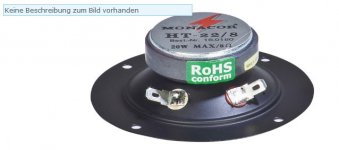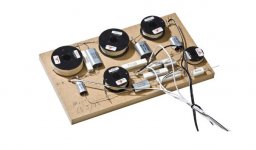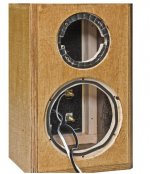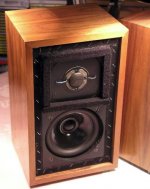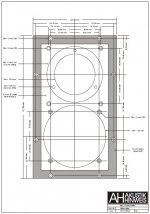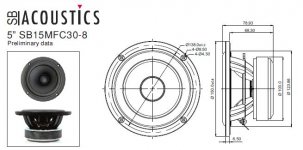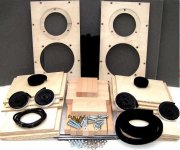I am leading to having some questions answered my friend System7.
From what I have read in some old organic chemistry books is that bextrene was originally synthesiized from wood resins. Rubber tires in automobiles used to be sourced from rubber plants. This was in the early days of modern organic chemistry. Today plastic is a by product of petroleum distillation.
From what I have read in some old organic chemistry books is that bextrene was originally synthesiized from wood resins. Rubber tires in automobiles used to be sourced from rubber plants. This was in the early days of modern organic chemistry. Today plastic is a by product of petroleum distillation.
I think we should move on from those old KEF Bextrene drivers now, beyond noting the rather obvious that a big bass is heavier construction than a bass/mid in every respect. Reading Joachim Gerhard's interesting comments, and a big thankyou for posting them for the DIYers, it's clear that modern drivers are far more detailed. Curiously, I found that modelling metal bass/mids, they are so fast that you really don't need to time align them to get phase reasonable with the tweeter. I know Mondogenerator has built a speaker with a Visaton AL130 metal bass and he will be especially interested in your comments, Joachim. 
I had a look around for a published design using that same SEAS 22TAF/G Metal Dome along with a very good SEAS W12CY003 Paper Mid/Bass. Mr. Troels Gravesen has done something he calls Eekel's Mini.
This is a 5 litre reflex with a very well designed crossover. The 900Hz peak is notched, the cone breakup gets a tank too. The tweeter has a Zobel. All this is good IMO. Needs some breaking in evidently, but certainly in the BBC tradition I reckon, and the cabinet construction details are up to you I'd say. The SEAS22 TAF/G tweeter seems to have none of that metallic zing that we sometimes hate. The bass/mid is pleasantly low inductance.
I had a look around for a published design using that same SEAS 22TAF/G Metal Dome along with a very good SEAS W12CY003 Paper Mid/Bass. Mr. Troels Gravesen has done something he calls Eekel's Mini.
This is a 5 litre reflex with a very well designed crossover. The 900Hz peak is notched, the cone breakup gets a tank too. The tweeter has a Zobel. All this is good IMO. Needs some breaking in evidently, but certainly in the BBC tradition I reckon, and the cabinet construction details are up to you I'd say. The SEAS22 TAF/G tweeter seems to have none of that metallic zing that we sometimes hate. The bass/mid is pleasantly low inductance.
Attachments
Greetings from Serbia!
It would be really stupid to invest serious money in old KEF drivers for LS3.5a clones. The sole world producer of Bextrene granules changed formulation over time without notifying loudspeaker manufacturers, hence notorious inconsistency of B110 drivers from different production runs! They added more and more fire retardant components which ruined Bextrene usefulness for loudspeaker drivers at the end of B110 life. The later 11Ω drivers had low Q absorptive vinyl front surrounds and their timing was not good as earlier version which had high Q springy Neoprene instead. This detail is particularly important.
It would be really stupid to invest serious money in old KEF drivers for LS3.5a clones. The sole world producer of Bextrene granules changed formulation over time without notifying loudspeaker manufacturers, hence notorious inconsistency of B110 drivers from different production runs! They added more and more fire retardant components which ruined Bextrene usefulness for loudspeaker drivers at the end of B110 life. The later 11Ω drivers had low Q absorptive vinyl front surrounds and their timing was not good as earlier version which had high Q springy Neoprene instead. This detail is particularly important.
That's very interesting, ivanlukic. You're saying that the Bextrene drive units went downhill with time...I have to agree they sounded slow to me.
I was looking into this whole KEF T27 mylar tweeter business following mondogenerator's remarks. It's quite strange to uncover yet another living fossil. But here is the efficient Mylar 94mm Vifa D19TD-05-08 still available at Parts Express in the USA:
Vifa D19TD-05 3/4" Poly Dome Tweeter 264-500
This bears an uncanny physical resemblance to the current SEAS 19TFF Soft Dome. You have seen and heard these Vifas in old Monitor Audio, Mission and JPW designs. It's also not dissimilar to the 98mm Celestion HF2000 and the 104mm KEF T27 and is probably a good replacement with a bit of resistor padding. Along with the Visaton DT94, it has a peakyness around 10-15 kHz, which could be readily filtered out I'd reckon. But off-axis dispersion is exemplary.
I gotta admit I am now quite undecided about tweeters. Spendor like the fabric SEAS 22TFF, Harbeth (and Joachim) like the hybrid metal SEAS 22TAF/G as modern replacements. Add mylar domes and paper cone tweeters, and it's really hard to choose.
I was looking into this whole KEF T27 mylar tweeter business following mondogenerator's remarks. It's quite strange to uncover yet another living fossil. But here is the efficient Mylar 94mm Vifa D19TD-05-08 still available at Parts Express in the USA:
Vifa D19TD-05 3/4" Poly Dome Tweeter 264-500
This bears an uncanny physical resemblance to the current SEAS 19TFF Soft Dome. You have seen and heard these Vifas in old Monitor Audio, Mission and JPW designs. It's also not dissimilar to the 98mm Celestion HF2000 and the 104mm KEF T27 and is probably a good replacement with a bit of resistor padding. Along with the Visaton DT94, it has a peakyness around 10-15 kHz, which could be readily filtered out I'd reckon. But off-axis dispersion is exemplary.
I gotta admit I am now quite undecided about tweeters. Spendor like the fabric SEAS 22TFF, Harbeth (and Joachim) like the hybrid metal SEAS 22TAF/G as modern replacements. Add mylar domes and paper cone tweeters, and it's really hard to choose.
Attachments
I heard SEAS 22TAF/G in Harbeth Compact7 ES3 many times and they sounded OK. No misbehaviour at all. I like that tweeter very much.
But for me the most practical solution would be to buy Monacor LS 5/19 kit. Herr Kuhl from Monacor did fantastic job, I think. And the price is not too high.
But for me the most practical solution would be to buy Monacor LS 5/19 kit. Herr Kuhl from Monacor did fantastic job, I think. And the price is not too high.
Another useful info for system7: tweeter in Monacor kit is made of Supronyl which I believe is similar to original Mylar dome in KEFs. I believe that Monacor kit is very similar to original LS3/5a but better in bottom end, more detailed and higher precision, better attack.
I think you are right, ivanlukic, this Monacor LS 5/19 is quite doable. I had a look at it in post #43, but let's reprise. Bass notch plus a notch on the mylar tweeter peak at 10-15kHz. Otherwise standard sort of 2nd. order bass, 3rd order tweeter which is good on phase alignment at crossover. Plenty of adjustment on tweeter level available on R3.
Monacor SPH-145HQ £41 5.5" Paper bass.
119mm cutout. 145mm dia, rebate 6mm. Qts=0.44, Vas=9.4L. Qms=3.07. Rdc=5.8. Ind=0.53mH. Fs=52Hz. 88dB.
Monacor DT-19SU £27 mylar type 19mm dome tweeter.
60mm cutout. 100mm dia, rebate 2mm. 91dB.
Link for kit:
Strassacker: Lautsprecher - Boxen - Selbstbau
Construction details:
Test Lautsprecherbausätze - Monacor LS 5/19 -
Cabinet is about 6L which is close to the 6.2L value I calculated, and accords with Vas and Qts with a low resistance bass coil. External 310mm H x 190mm W X 172mm D for 12mm ply AFAIK. Slightly bigger for 15mm ply. Battens must be some sort of softish (Rahman?) 16mm timber. Bitumen damping on all panels plus polyfill stuffing.
Flush mounting is important. I found that recessing the bass 12mm to the back of the baffle BBC style messed up phase at crossover by 50 degrees, which would need a crossover modification to correct.
Classic cabinet internal dimensions for optimal non-resonance are 0.618 x1.0x 1.618 (Golden Ratio) or 0.8 x1.0 x1.25 for those who like to tinker. Since they are cheap as chips, I include the cone tweeter Monacor HT-22 which might be fun to try too.
An externally hosted image should be here but it was not working when we last tested it.
An externally hosted image should be here but it was not working when we last tested it.
Monacor SPH-145HQ £41 5.5" Paper bass.
119mm cutout. 145mm dia, rebate 6mm. Qts=0.44, Vas=9.4L. Qms=3.07. Rdc=5.8. Ind=0.53mH. Fs=52Hz. 88dB.
Monacor DT-19SU £27 mylar type 19mm dome tweeter.
60mm cutout. 100mm dia, rebate 2mm. 91dB.
Link for kit:
Strassacker: Lautsprecher - Boxen - Selbstbau
Construction details:
Test Lautsprecherbausätze - Monacor LS 5/19 -
Cabinet is about 6L which is close to the 6.2L value I calculated, and accords with Vas and Qts with a low resistance bass coil. External 310mm H x 190mm W X 172mm D for 12mm ply AFAIK. Slightly bigger for 15mm ply. Battens must be some sort of softish (Rahman?) 16mm timber. Bitumen damping on all panels plus polyfill stuffing.
Flush mounting is important. I found that recessing the bass 12mm to the back of the baffle BBC style messed up phase at crossover by 50 degrees, which would need a crossover modification to correct.
Classic cabinet internal dimensions for optimal non-resonance are 0.618 x1.0x 1.618 (Golden Ratio) or 0.8 x1.0 x1.25 for those who like to tinker. Since they are cheap as chips, I include the cone tweeter Monacor HT-22 which might be fun to try too.
Attachments
i have to agree that the 5/19 kit looks nice.
Joachim, or anyone else are more than welcome to comment or copy my visaton TQWT design. Many helped and contributed, and the xo is almost a copy of the vib130tl project on their site. As an aside, the visaton TL despite the 'old' methods of design is also worthy of note, and should be fantastic! Its not bookshelf though
Joachim, or anyone else are more than welcome to comment or copy my visaton TQWT design. Many helped and contributed, and the xo is almost a copy of the vib130tl project on their site. As an aside, the visaton TL despite the 'old' methods of design is also worthy of note, and should be fantastic! Its not bookshelf though
Last edited:
I thnik you're posting from your mobile phone again, mondo...
If you want some opinions from people on your Visaton AL130 "TQWT" aluminium woofer design, you need to post the link to avoid turning it into a huge homework question, which is: http://www.diyaudio.com/forums/multi-way/214989-tqwt-visaton-al130-g20sc-finished.html
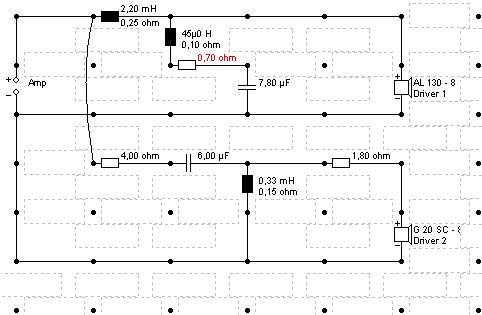

I've been looking into this BBC Birch Ply and Beech Fillets/battens idea. The BBC said that anything other than Beech was worse here. Seems Birch Ply (1300 rating Janka Scale) is a lot harder than softwood pine or fir ply (400 Janka Scale) that builders often use. Beech is an absorbent hardwood (Rated 1300 on Janka Scale) that is as hard as Oak, but has a very fine grain with good absorbtion and is the timber of choice for tough hardwood flooring. Ply has many forms suitable for boats, aircraft and furniture. Evidently a lot of its strength comes from the outer layers which are often a hardwood, and for some reason, odd number of laminates are preferred.
If you want some opinions from people on your Visaton AL130 "TQWT" aluminium woofer design, you need to post the link to avoid turning it into a huge homework question, which is: http://www.diyaudio.com/forums/multi-way/214989-tqwt-visaton-al130-g20sc-finished.html


I've been looking into this BBC Birch Ply and Beech Fillets/battens idea. The BBC said that anything other than Beech was worse here. Seems Birch Ply (1300 rating Janka Scale) is a lot harder than softwood pine or fir ply (400 Janka Scale) that builders often use. Beech is an absorbent hardwood (Rated 1300 on Janka Scale) that is as hard as Oak, but has a very fine grain with good absorbtion and is the timber of choice for tough hardwood flooring. Ply has many forms suitable for boats, aircraft and furniture. Evidently a lot of its strength comes from the outer layers which are often a hardwood, and for some reason, odd number of laminates are preferred.
Last edited:
I'm not sure if anyone has linked to this yet - the unofficial LS3/5a support site with a lot of information:
The Unofficial LS3/5A Support Site
If you go to the Library and Links page on that site, the Trevor Butler Little Legend article is also there.
The Unofficial LS3/5A Support Site
If you go to the Library and Links page on that site, the Trevor Butler Little Legend article is also there.
Last edited:
More on the original design and specification in this PDF
http://www.g4dcv.co.uk/ls35a/pics/BBC's_home_service.pdf
http://www.g4dcv.co.uk/ls35a/pics/BBC's_home_service.pdf
haha a free 'plug'! Yes mobile, either way i havent worked out how to post links! On topic tho, there is a wealth of info on the 'tribute' site. For what its worth, i have always used pine battens and thought them 'good enough', although almost anything is perhaps an improvement on pine.
Last edited:
thanks Col i may read them again since i dont recall the results of pine battens. How exactly they would impact a 'not BBC not thin wall' construction i dont know. Whilst my box is ply and not uber thick, half of the volume is solid MDF. The only battening is to support the baffle.
Last edited:
Speaking of the visaton drivers I have.....I hadnt considered trying to make a small monitor like the LS3/5A using the AL130.....
Im surprised to say that in Boxsim, (using the published values) it gives an F3 of ~90 Hz, so very similar to the 'real' LS3/5A, but in a volume of 5 litres, moderately stuffed.
This is what Boxsim, spits out:
http://files.diyaudio.com/forums/ga...m/AL130_G20SC_5_litre_sealed_bookshelf-FR.jpg
and the crossover for a golden ratio dimensioned box, of 5 litre net volume.
http://files.diyaudio.com/forums/gallery/data/1766/AL130_G20SC_5_litre_sealed_bookshelf-XO.jpg
Not too bad...
I think its fair to say the 'average' SPL is about 80 dB/W/m, so probably on par with the original.....
I may have to try it out!
Im surprised to say that in Boxsim, (using the published values) it gives an F3 of ~90 Hz, so very similar to the 'real' LS3/5A, but in a volume of 5 litres, moderately stuffed.
This is what Boxsim, spits out:
http://files.diyaudio.com/forums/ga...m/AL130_G20SC_5_litre_sealed_bookshelf-FR.jpg
and the crossover for a golden ratio dimensioned box, of 5 litre net volume.
http://files.diyaudio.com/forums/gallery/data/1766/AL130_G20SC_5_litre_sealed_bookshelf-XO.jpg
Not too bad...
I think its fair to say the 'average' SPL is about 80 dB/W/m, so probably on par with the original.....
I may have to try it out!
Last edited:
I was scratching my head over whether it is possible to use that Falcon Acoustics LS3-5A Kit with modern drivers. Apart form the Monacor SPH-135/AD and SPH-135TC Mid/Woofers, I haven't found ANYTHING that will fit. 
You have a 121mm hole and 4 screws on a roughly 135mm diameter PDC. Tweeter rebate is 108mm. Problem is the beech battens only give you about 133mm width with mounting on the back of the baffle which scuppers your chances with the SB Acoustics polycone below. FWIW, the design uses 9-layer 12mm birch ply and 16mm beech battens, although the front panel is 9mm 7-layer birch ply. It does look possible to fit a different 12mm front baffle with a rebate. Especially with a small unit like the Visaton AL130 or W100S where the Vas works out OK even if it's not a polycone.
Timber is not something I knew a lot about. But Yellow Birch ply is vastly (X4) harder than floppy pine ply. Pinkish Beech battens are vastly (X4) more rigid than floppy pine battens too. Other choices for hardwood front baffle laminating and battens can be maple, used in guitar stems and violins, and surprisingly, Lime aka Linden aka basswood, which is used in the stems of bass guitars and is an ungrainy hardwood. Happens I tested some Lime for strength in 1987 in Holland Park, London, when "Lime Walk" all blew down one very windy night...
Lime is that stuff with the big green sticky leaves that dumps goo on your car if you foolishly park under it. Beech trees are interesting because they fuse branches with adjacent trees to produce a stronger structure. These are hardwood trees of the mature forest. Pine and Spruce and Fir adopt a more flexible strategy in exposed places as firstcomers. They BEND with the wind...
I would presume birch is quite bendy too, since it is a firstcomer in woodland too. Bottom line, is these BBC cabinets are a lot more rigid than I thought initially, and the hardness of the panels and battens seems to be quite well matched. I really don't know much about the equally important damping properties.
You have a 121mm hole and 4 screws on a roughly 135mm diameter PDC. Tweeter rebate is 108mm. Problem is the beech battens only give you about 133mm width with mounting on the back of the baffle which scuppers your chances with the SB Acoustics polycone below. FWIW, the design uses 9-layer 12mm birch ply and 16mm beech battens, although the front panel is 9mm 7-layer birch ply. It does look possible to fit a different 12mm front baffle with a rebate. Especially with a small unit like the Visaton AL130 or W100S where the Vas works out OK even if it's not a polycone.
Timber is not something I knew a lot about. But Yellow Birch ply is vastly (X4) harder than floppy pine ply. Pinkish Beech battens are vastly (X4) more rigid than floppy pine battens too. Other choices for hardwood front baffle laminating and battens can be maple, used in guitar stems and violins, and surprisingly, Lime aka Linden aka basswood, which is used in the stems of bass guitars and is an ungrainy hardwood. Happens I tested some Lime for strength in 1987 in Holland Park, London, when "Lime Walk" all blew down one very windy night...
An externally hosted image should be here but it was not working when we last tested it.
Lime is that stuff with the big green sticky leaves that dumps goo on your car if you foolishly park under it. Beech trees are interesting because they fuse branches with adjacent trees to produce a stronger structure. These are hardwood trees of the mature forest. Pine and Spruce and Fir adopt a more flexible strategy in exposed places as firstcomers. They BEND with the wind...
I would presume birch is quite bendy too, since it is a firstcomer in woodland too. Bottom line, is these BBC cabinets are a lot more rigid than I thought initially, and the hardness of the panels and battens seems to be quite well matched. I really don't know much about the equally important damping properties.
Attachments
- Status
- This old topic is closed. If you want to reopen this topic, contact a moderator using the "Report Post" button.
- Home
- Loudspeakers
- Multi-Way
- LS3/5a mini monitor clones
